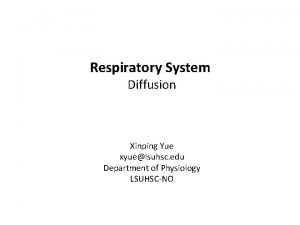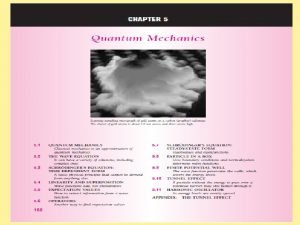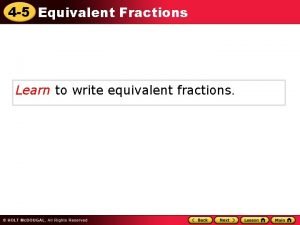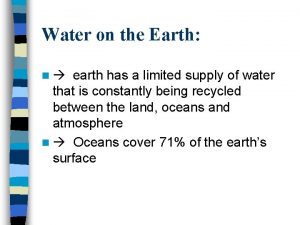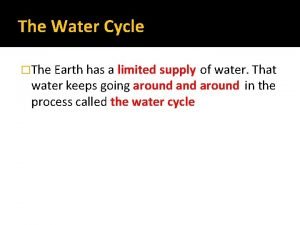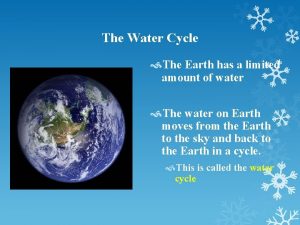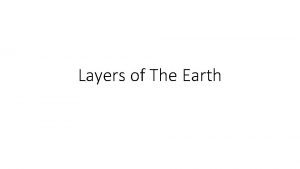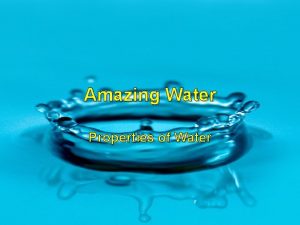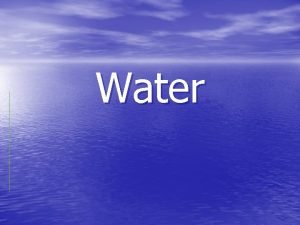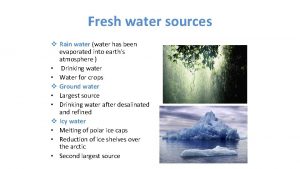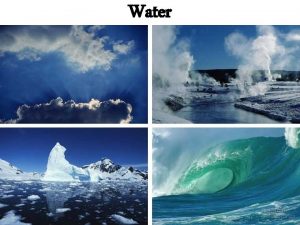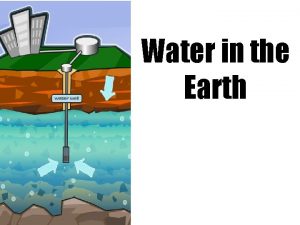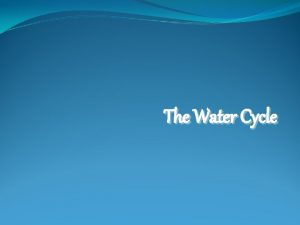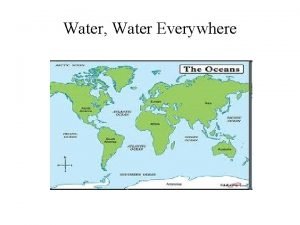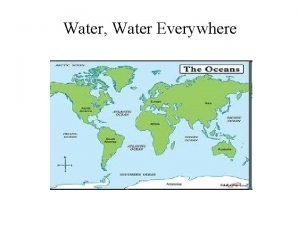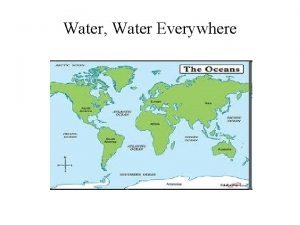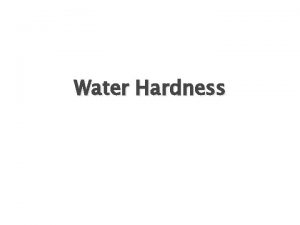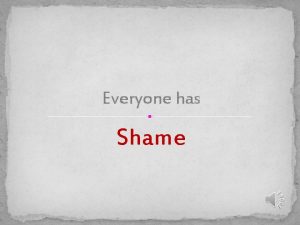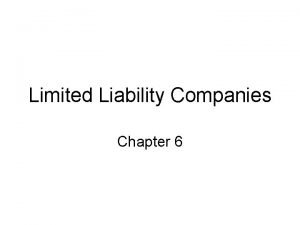Water on the Earth earth has a limited
























- Slides: 24

Water on the Earth: • earth has a limited supply of water that is constantly being recycled between the land, oceans and atmosphere • Oceans cover 71% of the earth’s surface

The Water Cycle (Hydrologic Cycle) • Earth’s limited supply of water is constantly being recycled between the oceans, atmosphere and land condensation transpiration precipitation evaporation Run off infiltration condensation ocean

Water entering the atmosphere: (powered by the sun’s energy) 1) evaporation surface water changing to water vapor • 2) transpiration process by which living things release water vapor to the atmosphere • 3) evapotranspiration a combination of evaporation and transpiration •

Water vapor in the atmosphere rises, cools and condenses. • condensation the process by which water vapor changes to liquid water -- releases energy

Water returning to the Earth’s surface: precipitation water falling to the Earth’s surface

Water returning to the Earth’s surface: • 1) runoff water on the surface of the Earth moving toward lakes, rivers and oceans • 2) infiltrate sink into the ground through spaces in the soil • Runoff + infiltration = 100% of precipitation

Water below the Earth’s surface groundwater that infiltrates the ground • Gravity pulls water down to the until it reaches the: • zone of saturation the area where the soil is saturated with water (all spaces, cracks and openings in the soil grain and rocks are completely filled with water)

• Where does the zone of saturation end? • impermeable rock layer of solid rock that will not allow water to pass through • Where does the zone of saturation start? • water table the uppermost surface of the saturated zone between the zone of aeration and the zone of saturation • zone of aeration area where the soil does not contain water between particles

• The soil and rock act as a natural filter making ground water a good source of drinking water. • Wells are drilled into the ground to extract ground water for human consumption. If the water is pumped too quickly the well will run dry.

Water Below the Surface

Factors that affect the storage and Movement of Groundwater. • Storage and movement of groundwater is controlled by the characteristics of the soil and rock found near the surface.

Water can infiltrate when there are many openings, or pores between ground particles. Porosity the volume of pores in a material compared with its total volume determine the amount of water the ground can hold Pore Space

factors affecting porosity • o shape - round particles have greater porosity that angular particles • o packing – loosely packed particles have greater porosity than tightly packed particles

• sorting -- well sorted (all particles of the same size) have greater porosity than poorly sorted (mixture of particles sizes)

• particle size does not effect porosity • o large and small particles have the same porosity

permeability • the ability of soil to transmit water, how fast water can pass through a soil Dependent upon • size of the pores • how the pores are connected

Size of the pores: • o large pores created by sand allows water to pass through quickly • o small pores created by clay allows water to pass through slowly

Infiltration is directly related to permeability • increase infiltration, increase permeability • decrease infiltration, decrease permeability

Runoff is inversely related to infiltration and permeability • increase infiltration and permeability, decr runoff • decrease infiltration and permeability, incr runoff

Capillarity • water has the ability to move upward in tiny spaces between soil grains, due to the cohesive nature of the water molecule • capillary water is water available for plants to access with their roots

Rainfall and Stream Flow • Streams and rivers do not respond immediately to rainfall • Streams will respond more quickly if the land is steep, without vegetation or there is paved areas Any factor that decreases infiltration will increase runoff


Watersheds and Drainage Divides • Watershed (drainage basin) the geographic area that drains into a particular stream or other body of water • Drainage divide boundary between two watersheds

nage Drai de Divi
 Water and water and water water
Water and water and water water Perfusion limited vs diffusion limited
Perfusion limited vs diffusion limited Quantum wave equation
Quantum wave equation A particle limited to the x axis has the wave function
A particle limited to the x axis has the wave function 4/5equivalent fractions
4/5equivalent fractions Hát kết hợp bộ gõ cơ thể
Hát kết hợp bộ gõ cơ thể Frameset trong html5
Frameset trong html5 Bổ thể
Bổ thể Tỉ lệ cơ thể trẻ em
Tỉ lệ cơ thể trẻ em Voi kéo gỗ như thế nào
Voi kéo gỗ như thế nào Glasgow thang điểm
Glasgow thang điểm Chúa yêu trần thế alleluia
Chúa yêu trần thế alleluia Môn thể thao bắt đầu bằng từ chạy
Môn thể thao bắt đầu bằng từ chạy Thế nào là hệ số cao nhất
Thế nào là hệ số cao nhất Các châu lục và đại dương trên thế giới
Các châu lục và đại dương trên thế giới Công thức tính thế năng
Công thức tính thế năng Trời xanh đây là của chúng ta thể thơ
Trời xanh đây là của chúng ta thể thơ Mật thư tọa độ 5x5
Mật thư tọa độ 5x5 Phép trừ bù
Phép trừ bù Phản ứng thế ankan
Phản ứng thế ankan Các châu lục và đại dương trên thế giới
Các châu lục và đại dương trên thế giới Thể thơ truyền thống
Thể thơ truyền thống Quá trình desamine hóa có thể tạo ra
Quá trình desamine hóa có thể tạo ra Một số thể thơ truyền thống
Một số thể thơ truyền thống Cái miệng nó xinh thế chỉ nói điều hay thôi
Cái miệng nó xinh thế chỉ nói điều hay thôi

